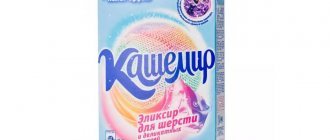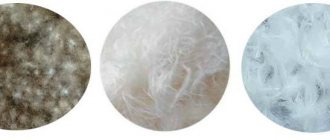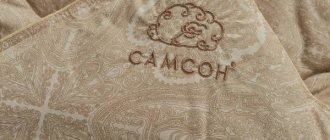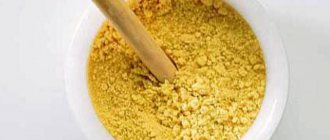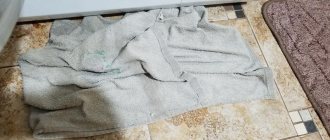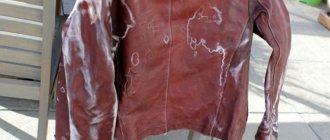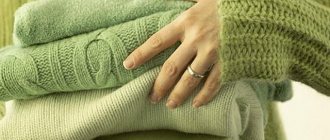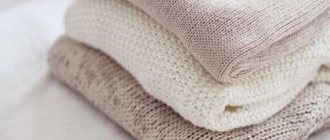Wool products are attractive, but require some care. It is necessary to correctly select a detergent for washing wool, otherwise the item quickly loses its appearance qualities - it shrinks or stretches, pellets appear on the surface, etc. Not only the selected composition plays a role, but also the actual process of washing, drying and ironing.
Caring for wool products
Clothes are made from various wool - Angora goat, sheep, camel and others. Regardless of the original origin, wool is always a natural fiber that needs to be treated with care. Each type of wool has some of its own care points, but the basic recommendations of the manufacturer of a particular item differ little and are generally the same for all varieties:
- Wool should be washed in warm water. This material does not respond well to both cold and hot water.
- Natural fibers do not like alkaline detergents, so you need to carefully review the composition of the detergent. They also sell specialized products for wool products.
- It is not recommended to wash woolen items frequently. If there is no significant contamination, washing is needed no more than once every 7 days. When an item sits for a long time and is not worn, then it is permissible not to wash, for example, a hat, for up to six months.
- Soaking for a long time in water is not recommended. Washing, in general, should not take more than 1 hour. The less the product comes into contact with moisture, the less likely it is to deform.
For reference! Stains from woolen clothing can be removed without damaging the structure of natural fibers using vinegar and hydrogen peroxide.
Preparing for washing
To prevent damage to woolen products, so that they do not stretch or shrink, it is necessary to properly prepare them. Before you start washing, you should check the product for stains. Contaminants must be removed before putting clothes into the machine or soaking them in a basin. There are a number of preparatory steps that prevent damage to the structure of natural fibers:
- If possible, any fittings on which woolen threads may get caught are removed. These elements can also oxidize during washing and leave stains on clothes.
- Loops, if this element is present on the product, are sewn up during washing.
- Colored and white items are washed separately. In the case of dyed wool, it is sorted by tones and their saturation.
- The item is turned inside out.
- Before washing with other items, each item, especially when the clothes are new, needs to be checked to see if it is fading or not. To do this, you need to moisten the corner with warm water and then blot it with a white napkin. If the pigment leaves traces, then you need to fix the color.
- Fluffy items are combed before washing to get rid of surface dirt and tangles.
Wool products should only be washed separately from other types of materials. If care is not followed, owners of woolen items are faced with loss of color and softness, shrinkage, deformation of the product and the appearance of pilling. And the clothes that were washed with it become covered with hard-to-clean lint.
Temperature
One of the main points is the correct selection of the temperature at which washing woolen items is safe for their appearance and structure. The best option is the water temperature, which is in the range of 30-40 °C. When washing woolen items by hand at this temperature, it is better to choose hair shampoo instead of washing powder and gels. The temperature of the rinse water should also be within these limits. It’s good when it doesn’t differ at all from what it was when washing.
Attention! It is necessary to wash woolen items in a machine at a minimum speed, with cold water and without spinning. As an addition, it is possible to install another rinse.
How to wash wool by hand and in a machine
It is better if woolen items are washed by hand. But even when natural fiber products are cleaned in the washing machine, the main thing is to approach this process correctly so as not to spoil the item. Before washing wool, you need to make sure that all zippers and buttons are fastened, and other stages of preparation have been completed. When washing by hand, you must follow the following sequence of actions:
- Warm water up to (40 °C) is filled into a basin or bathtub. You need quite a lot of liquid, since the yarn absorbs moisture well.
- The amount of detergent for washing wool or delicate fabrics that is indicated in the instructions is added to the water. The soap solution must become homogeneous. When there is no special product, use hair shampoo. The water should be soapy, but not overly soapy.
- The yarn is dipped into the liquid and left for 15 minutes. After time, it is necessary to carefully wash heavily soiled areas of the product.
- Afterwards, you need to rinse the woolen item several times with water at the same temperature and gently squeeze out the excess water. Twisting into a bundle is prohibited.
- When the bulk of the liquid has been gently squeezed out, the items are laid out to dry.
The greatest harm is caused by squeezing and temperature fluctuations. Wash woolen items correctly without spinning - this will preserve the original appearance and structure of the wool over many seasons of wear. When, after all the manipulations, the material begins to crack, this indicates excessive hardness of the tap water. To prevent the item from being itchy after washing, add a little table vinegar to the water.
Machine washable
It is more convenient to wash in a washing machine than by hand, but this method is not suitable for every type of product. First, make sure that the manufacturer allows cleaning in the machine, then set the delicate mode or the special “Wool” program.
Important point: turn off the spin function or set it to no more than 400 rpm. After removing from the drum at the end, remove additional water by gently pressing the product. It is prohibited to twist the wool during spinning!
Advice! After you have removed the wet woolen clothing from the device, place it on a terry towel. It will absorb excess liquid well.
How to dry woolen items correctly
It is important not only to wash wool correctly, but also to take all precautions when drying products made from this material. Following certain rules will help protect woolen items from damage. The main thing when drying such things is the absence of outside influence. It is forbidden to leave yarn to dry on a clothesline, as the product will stretch; near heating devices and in the sun, the item will shrink. When drying wool, it is recommended to proceed as follows:
- The item is placed on a towel and rolled together into a tube. This will cause excess moisture from the woolen product to be absorbed into the terry towel, speeding up the drying process.
- After the first drying, the clothes are spread on a flat surface on top of a dry towel.
- The room where the woolen item dries is well ventilated.
For reference! They sell specialized dryers that guarantee quick and even drying of woolen clothes.
Mohair and angora yarn will retain their fluffiness if, after drying with a towel, they are tightly wrapped in a plastic bag and placed in the freezer. Afterwards, products made from these materials are dried according to the general rules for wool. If the room is cool and you need a dry item urgently, you can speed up the process with a hairdryer. But it is permissible to use only cold air and not bring the hairdryer close - there must be a distance of at least 30 cm.
The ban on the use of heating devices when drying, in particular radiators and heaters, is due to the fact that exposure to high temperatures (from 60 °C) on the product leads to fragility of the fibers. The material quickly deteriorates and yellowish spots appear on it. Wool threads become thinner and break easily. The higher the temperature, the faster the product becomes unusable.
Ironing woolen items
Ironing wool products is not recommended, but there are emergency situations when it is necessary. In order not to harm the structure of natural fibers, you need to follow some rules during the ironing process. The first and most important point is to study the tag on the product, which contains brief recommendations from the manufacturer for caring for a specific item. Other rules for ironing woolen items are as follows:
- ironing under-dried clothes is prohibited;
- The steaming function cannot be used;
- During ironing, you need to monitor the condition of the material;
- Before ironing, be sure to turn the product inside out;
- You cannot apply pressure with the iron, it must be applied without effort;
- iron only through gauze or cotton cloth;
- iron only the crease areas.
Attention! It is better to take care of sweaters, dresses and other woolen clothes and do not use an iron on the items after each wash. Ironing is allowed only in exceptional situations - the thermal effect on the wool has a negative effect. You should not iron such items more than 1-2 times a month. Be sure to follow all safety precautions during the process.
The best fabric softeners
Conditioners have a softening and antistatic effect, so they are indispensable at the final stage of washing terry towels, bedding, underwear, children's clothing and thin synthetic fabrics. Their formulas contain special polymers that preserve the brightness of fabrics, provide a dirt-repellent effect and significantly simplify the ironing process. In addition, most air conditioners have pleasant perfumed or natural fragrances that remain as an unobtrusive veil on clean linen.
KAO Humming Fine Concentrated fabric softener
5
★★★★★
editorial assessment
100%
buyers recommend this product
Does your laundry acquire a musty aroma after drying? The Japanese rinse aid will quickly correct the situation, at the same time giving extraordinary softness to even hard cotton products.
The product in a 570 ml plastic bottle has a liquid gel texture and a luxurious jasmine aroma. Polymers, aromatic oils and bactericidal components in its composition effectively eliminate unpleasant odors, prevent the formation of wrinkles on clothes and eliminate microbes formed when drying clothes in an unventilated room.
KAO Humming Fine is used at the final stage of hand or machine washing. Add it at the rate of 7 ml per 1 kg of laundry. Regular use of the concentrate will preserve the density and saturation of fabric fibers, and will not cause unpleasant reactions in allergy sufferers.
Advantages:
- Pleasant aroma of jasmine;
- Safe composition;
- Minimum consumption;
- Bactericidal effect;
- Softens laundry;
- Gives an antistatic effect.
Flaws:
- The price is high.
KAO conditioner will be appreciated by lovers of perfumed floral fragrances, whose wardrobe is dominated by linen, thin synthetic and silk clothing.
Chicco Sensitive Concentrated Softener
4.9
★★★★★
editorial assessment
95%
buyers recommend this product
Safe conditioner for baby clothes from the Spanish company Chicco has a subtle vanilla aroma that unobtrusively remains on fabrics. The liquid concentrate is sold in a plastic yellow bottle with a volume of 750 ml. The composition is suitable for machine and hand washing. It is used economically: for a machine with a loading of 5 kg it will be enough for 30 or more uses.
Due to the absence of chlorine, phosphates and aggressive chemical fragrances, the conditioner can be used to rinse diapers and children's underwear. It effectively softens hard natural fabrics, eliminates static from synthetic materials, facilitates ironing and provides a bactericidal effect.
Advantages:
- Pleasant vanilla aroma;
- Safe composition;
- Can be used from the first days of a child’s life;
- Softening and bactericidal effect;
- Economical and relatively inexpensive.
Flaws:
- Not suitable for children with a hypersensitive sense of smell.
Chicco conditioner is suitable for rinsing any children's laundry. Adults with allergies, as well as fans of vanilla aroma, will appreciate it.
Tactics if woolen clothing shrinks
Woolen clothes shrink at the slightest temperature increase during washing. It is possible to return things to their original size, but the result will not always be as expected. Much of the success depends on the degree of shrinkage of the product - it is impossible to guarantee 100% achievement of the result. There are several techniques that can potentially return a shrunken wool item to its original parameters:
- When the yarn contains synthetic fibers, such clothes can return to their original size after 2 hours of soaking in 10 liters of cold water with 2 tbsp. hydrogen peroxide. After briefly drying with a towel, the product is left to dry. Periodically it is necessary to stretch the shrunken product into shape while it dries.
- With a high degree of probability, it is possible to return a woolen item to its previous size if you lay it out damp on an ironing surface, put a towel on top and iron it, carefully stretching it in the necessary places.
- You can return it to its original appearance using vinegar. A sponge is soaked in the liquid and the item is treated. Afterwards, the product is laid out on a horizontal surface, stretched to the required size and left to dry.
- If the sweater has shrunk, then it is permissible to wash it again with hair shampoo, lay it out on a hard surface while damp, and secure it in the required position with pins until it dries completely.
- You can stretch clothes made of natural wool by washing in 5 liters of water with 3 tbsp. ammonia and 1 tbsp. turpentine. The algorithm of actions is the same as in the case of repeated washing with shampoo.
Caring for wool clothing is a painstaking task. But if you do not follow the recommended rules, the product will quickly become unusable - it will become deformed, become hard, prickly, and pellets and matted areas will appear on it. All instructions regarding woolen products are mandatory, as they were developed empirically so that the items would last a long time and not lose their appearance over the years.
Folk remedies
Mustard powder is used to wash dark clothes. 1 glass of dry matter is dissolved in a small amount of water, filtered and allowed to brew, then added to a basin and washed. An alternative to industrial air conditioners is ammonia. 1 teaspoon of the substance will soften the fabric.
Washing white wool items is a separate issue. When machine washing, bleach may be added. Hydrogen peroxide refreshes yellowed clothes: 1 tablespoon of peroxide per 1 liter of water. Soak the clothes briefly in this solution, then wash and rinse well.
Another effective folk method is crushed chalk. You will need 1 kg per 3 liters of water. Soak the yellowed wool item in the solution, then wash it. The canvas will bleach.
The wool has stretched
If washing rules are not followed, products made from natural wool may stretch. To partially restore the original appearance of a thing, you need to turn it inside out. Then put a layer of gauze or thick natural fabric on top and iron it with an iron. When the product is not completely deformed, but a separate element, for example, sleeves, is stretched, they should be soaked for 10 minutes in warm water. Then dry with a towel and leave to dry on its own.
For reference! When the item stretches by more than 1 size, the item is immersed in hot (40-50 C) water. But, it is necessary to take into account that this technique is extremely aggressive towards woolen products and destroys the structure of the material. In addition, clothing may shrink more than necessary. For this reason, this technique is used only when other options have not given a positive result.
General Tips
To maintain the normal appearance and condition of a woolen item, sometimes it is not enough to follow the standards of care. There are products that require a more thoughtful attitude and a complete list of rules and regulations, for example, some woolen sweaters must be checked for the possibility of shedding before washing. In order for the item to last longer it is necessary:
- When storing woolen items, additional moth repellents should be placed in the closet. As such, you can use soap or pieces of dried citrus peel.
- If there are long loose loops on the product, they must be picked up and carefully hemmed, otherwise during the washing process they may stretch out and lead to the unraveling of the knitting.
- When cleaning items made from soft wool like alpaca or mohair, hand washing with shampoo is the best option. However, rinse thoroughly afterwards.
- When a washed wool product is itchy after drying, it is possible to soften the yarn with products containing lanolin.
- To remove stains on woolen items and generally whiten items, it is not necessary to use heavy chemical compounds - you can sprinkle the area to be cleaned with citric acid, moisten it and leave for 40 minutes.
- The total washing time should not exceed 40-50 minutes. This mode will preserve the structure of the material as much as possible - there is less risk of things stretching or distorting.
Clothes made from wool can last for a long time if all storage conditions are observed, and in particular the rules of washing and drying. Careful attitude, the use of specialized washing products marked “for natural wool”, refusal of forced drying using heating devices is a guarantee of a long life of clothing and maintaining its original appearance unchanged.
How do you like the article?
